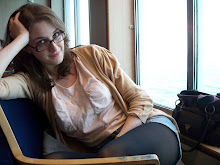
Sunday, 31 January 2010
Thursday, 28 January 2010
The Food Printer

Philips Design in Eindhoven, Netherlands, has designed some conceptual machines concerning food and the future of nutrition. This is part of an investigation of how people may live in 20 years time.
The Senior Director of design-led innovation at Philips Design, Clive van Heerden has said of the program; “We are very interested in new ways of looking at what we eat and the processes that food undergoes before we consume it.”
The Senior Director of design-led innovation at Philips Design, Clive van Heerden has said of the program; “We are very interested in new ways of looking at what we eat and the processes that food undergoes before we consume it.”
The investigations have looked at trends of our food and nutritional habits. Factors such as the growing popularity of organic foods, genetic modification, land use, patterns in growing food, food shortages, rising prices of food and progressions in medicine.
The Food Printer; The Food Printer would print food, into whatever consistency or shape is desired, such as foamy vegetables or chicken shaped like spaghetti. Insert some cartridges, press a button, then the printer will ‘print’ the food. The foods would be made from ingredients according to the nutritional needs of the user. According to Philips, this machine would use a similar process to rapid prototyping.
Tuesday, 19 January 2010
On the taff.
So I went taffing (searching through unwanted items for little treasures at the tip) and found some lovely bits and pieces there. I picked up a tan leather briefcase in near enough excellent condition, a stage light, an amp, a Kenwood food mixer, an old-school calculator with moving parts, some spare computer parts and an old-fashioned sewing machine in black and gold. I was a bit lost where to start but I thought I'd see how far I can get with found objects.
I considered methods of being more gluttonous; to eat faster, messier, without cutlery, more unhealthily, larger quantities of food, to eat everything at once. This led me to think about how machinery can play a part in this.
I questioned; how could it be possible to eat large quantities of unhealthy food, all at the same time, in a messy fashion. One idea would be to condense the food in a processor or mixer and consume the food through a tube or through some other method. Perhaps a tube straight into the stomach or even the veins, making the process of chewing, eating and swallowing obsolete for those who are obese.

I considered methods of being more gluttonous; to eat faster, messier, without cutlery, more unhealthily, larger quantities of food, to eat everything at once. This led me to think about how machinery can play a part in this.
I questioned; how could it be possible to eat large quantities of unhealthy food, all at the same time, in a messy fashion. One idea would be to condense the food in a processor or mixer and consume the food through a tube or through some other method. Perhaps a tube straight into the stomach or even the veins, making the process of chewing, eating and swallowing obsolete for those who are obese.

Sunday, 10 January 2010
Turner Prize.
New Year's Eve Poster.
 New Year's Eve poster. I originally planned on a different one.
New Year's Eve poster. I originally planned on a different one.I had made some small 3-dimensional letters from white card, spelling out 'KATIE B NYE' and I would have hung them up in a tree in my garden, took some photos and then scanned over a white stencil of 'The Oakwood.'
But it snowed a lot and I didn't want white letters on white snow, which would have made for an illegible poster.
So instead I took photos of my snowy garden, stenciled out the lettering, backed it with card, scanned it in, adjusted the brightness and contrast, printed off the finished thing, took it down to the pub and stuck it on the wall.
The Forests Have Ears and The Fields Have Eyes.

After doing so much research on Hieronymus Bosch for my essay, I found a drawing of his which I really like, maybe even more than his super-detailed paintings. 'The Forests Have Ears and The Fields Have Eyes' is a pen and ink drawing, perhaps from a notebook of some sort.
A lot of the time, sketchbooks, notebooks, diaries and journals interest me more than the finished pieces. I like to see how the ideas are accumulated, stretched and experimented with. How a tiny and seemingly insignificant doodle can become a huge exhibition. These crucial stages in planning work fascinate and inspire me.
Saturday, 9 January 2010
Subscribe to:
Comments (Atom)












